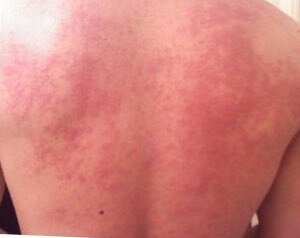The tableau is common enough these days: after a miscalculated meal, snack or sip, a parent rummages frantically for an EpiPen or antihistamine as a swollen-mouthed child sits, frightened, possibly gasping for breath.
Fifteen years after an experimental peanut allergy shot killed one patient, researchers have ramped up the science to find alternative treatments, including protein powders and herbal mixtures
The prevalence of food allergies has shot up in recent years and now affects some 8 percent of children in the U.S. And of the approximately six million kids who have food allergies in this country, more than a third (38.7 percent) have severe reactions. These responses, triggered by an immune system over-reaction, can lead to anaphylaxis, a systemic response that, if untreated, can be fatal.
With so many people just a bite or a drop away from a potentially deadly allergic reaction—and the cost of treatment for these allergies spiraling to about half a billion dollars in 2007—scientists have cast a wide net in the search for new and more effective ways to eliminate food allergies and have pulled in some promising approaches. Potential therapies—including peanut protein powders and mixes of traditional Chinese herbs—are moving quickly through clinical trials, and some might be ready for regulatory evaluation within a year.
Down the hatch and under the tongue
Shots for pollen and other airborne allergens have been around for decades. So, as food allergy rates started to rise a couple of decades ago, researchers got to work adapting this principle for the new set of patients. In 1996 12 people with severe peanut allergies entered a clinical trial studying an injectable vaccine. One child in the study, however, had a severe reaction to the shot and died, making many people wary of the field altogether.
But the growing number of people with food allergies has been reigniting interest. Newer research has moved on to therapies that adults and kids can take orally—many as a powder that can be mixed into juice or a snack, such as applesauce. Other candidates include drops that are placed under the tongue (and held there for a couple minutes before being swallowed).
The principle is simple enough: slowly acclimate the immune system to the offending protein starting with minute doses. The very first dose of an experimental oral peanut allergy therapy, for example, might include about one one-thousandth the amount of peanut protein as is found in a whole nut.
Over weeks and months, the quantity of the protein is slowly ramped up. “With the repeated administration of the dosing, your immune system begins to change,” explains Wesley Burks, the chief of Pediatric Allergy and Immunology at Duke University. For most people in the trials (which have each generally enrolled fewer than 30 subjects so far), their immune system starts to accept larger and larger quantities of the noxious protein. And after several months many previously allergic kids can eat a tablespoon of peanut butter without ill effect.
These oral-base therapies hold the most promise, says Robert Wood, chief of Allergy and Immunology at Johns Hopkins Children’s Center. He notes that a return to the injectable vaccine is still tentative (even though many speculate that the previous fatality was likely the result of a dosing error). Wood’s research has focused on milk allergies and has had especially promising results from powder formulas—in large part because of the administration route. He and his team have been able to work subjects up to as many as 2,000 milligrams of milk protein via that method, whereas the below-the-tongue approach has only reached about seven milligrams of the extract. (As he points out: “you can only put so much liquid under a person’s tongue and have them hold it there.”)
Related articles
- Is Your Child’s Food Allergy Testing Right? (everydayhealth.com)
- Novel approach to treat food allergies in kids (cbsnews.com)
- Foods with baked milk may help build tolerance in children with dairy allergies (medicalxpress.com)
- 1 in 13 US Kids Has Food Allergy (newser.com)











